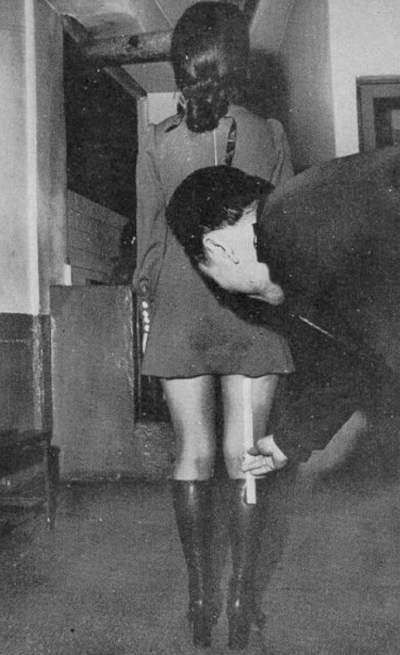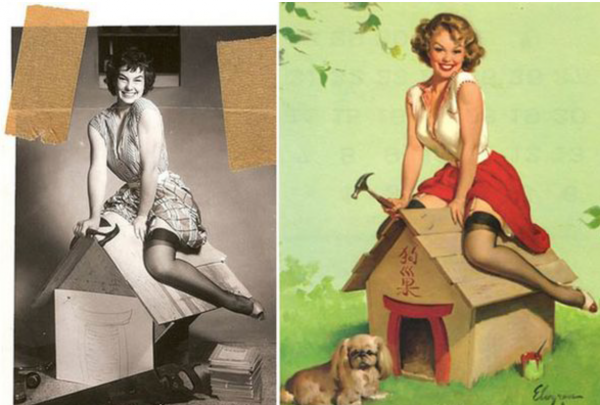- Date: 1973
Country: South Korea
Designer: Unknown
Model: Jang (23)
Indeed the trend of fashion has been changing rapidly each year, and the rate of change of fashion in South Korea has been unreal. Women were accustomed to wearing Korean traditional dresses called Hanbok until late 1920s, and clothings from western culture that were imported after colonization of Japan were 180 degrees different from Hanbok – while Hanbok hided almost every part of women’s flesh except for hands, feet, neck and face, mini-skirts that prevailed in 1970s of South Korea were too short and were percieved as indecent. As the society of Korea is based on extreme confucianism, women wearing mini skirts were thought as guilty, and there even existed the law that the length of mini skirt should never go higher than 15 centimeters over the knees. The image shows the scene where a policeman is measuring that length of mini-skirt stated by law. Jang, wearing a mini skirt which were 30 centimeters shorter than the length of her thigh, is known to be taken to police station right after the photo shoot.
From the image I chose, there are so many things that I could study about – how the fashion trend of Korean women changed from Hanbok to mini skirts, the historical context of such change, how the change of length of skirts were related to feminism in Korean society. Also, I personally enjoyed this image because I thought it portrayed the thirst to look beautiful and wear innovatively regadless of the regulations that the society had set. That also matches with my design moto – design to break the walls. Although this image does not involve any specific designers, I think it could still be a good topic.
Source: Dong-A Daily News, 1973 2/9
2. Date: 1947, February 12
Country: France
Designer: Christian Dior
Before explaining the context of the image, I first want to mention that I am obsessed with black and white(although the colored image of the top seems to be close to beige). Between the Tailleur Bar ensemble by Dior and the Little Black Dress by Chanel, I chose Dior’s work just because it fulfills my taste of aesthetics really well – the black and white goes along perfectly together, and the exaggerated curve of the model’s body is more than just beautiful. It is the most simple in its details, but the most glamorous in its volume. If my paper is based on this image, I would like to study about the change of the expression of woman’s curve in the garments – for instance, if this garment got any inspiration from the corsetry.
This ensenble in the image, called the Tailleur Bar or the simply the bar suit, is one of the garments of Christian Dior’s debut haute couture collection revealed in 1947 which is exactly 70 years ago. Unlike boxy shaped garments that prevailed in 20s and 30s by Chanel and Lanvin, Dior’s collection including the Tailleur Bar had very different shape as if they were thrown back to early 1900s when curvy silhouettes were prevailing.
Source: Pinterest, https://www.youtube.com/watch?v=6m1OcMzePqs
3. Date: 1961
Country: U.S.A
Model: Janet Rae
Designer(Artist): Gil Elvgren
As a feminist, I hated the concept of typical pin-up girls illustrations of 1950s. I hated the postures they made, how the artists portrayed the female as commodities, and how the illusts could have forced the ideal shape and characteristics of women’s beauty. (By pin-up girl, I am referring to the illustrations that were created and prevailed at mid 20th century due to military demand.) However, I think it is undeniable that the diverse illustrations of pin-up girls sums up the trend of fashion of that age. The exposure of the skin may be exaggerated, but it shows the ideal appearance of attractive women of that age.
The image I chose is the illustration done by Gil Elvgren, the most famous pin-up girl artist, and the original image of Janet Rae that became the inspiration for his illustration. There were many other images that Gil created, however as anyone could notice from the link of image archive that I attached below, more than half of them show women who are wearing only under garments, or naked. From the images that shows the fashion, I chose the one that I liked the most because the subject seemed less passive than others. Although the origin of pin-up girl is known to be the Gibson girl in 1890s, I would like to concentrate on 1940s to 70s when Gil Elvgren actively created his illustrations. I think I would be able to study the trend of fashion through the illustrations by Gil Elvgren and at the same time, find out whether the pin-up girl images also gave influence to the trend of fashion. In the paper, I would write more about the social context of pin-up girls and the trend of fashion behind them, rather than concentrating on specific designers.
Source: http://www.thepinupfiles.com/elvgren7.html

